

Matsyasana
«Matsyasana», the fish posture, is an Asana from Hatha Yoga, which is one of the 84 main asanas. «Matsyasana» is the fourth of the 12 Basic Postures of the Yoga Vidya series and is a liberating and strongly opening Asana. «Matsyasana» is always practiced after «Halasana» in Yoga-Vidya, on the one hand as «Counter-Position», on the other hand both positions are conditioned in such a way that the effects for both positions are intensified. After the «Matsyasana» the «Paschimothanasana» get practiced.
 «Matsyasana», — seen from the outside, the position looks like a fish
«Matsyasana», — seen from the outside, the position looks like a fish
Table of Contents
1.1 The physical effects of Matsyasana
1.1.1 Stretched muscles in Matsyasana
1.1.2 Strengthened muscles in Matsyasana
1.2 The mental effect of Matsyasana
1.3 The energetic effect of Matsyasana
1.3.1 Chakras specifically addressed
2.1 The Dissolution of the Position of Matsyasana
3 Tips for execution
4 Thoughts about Matsyasana
5 Matsyasana or Fish — Practical Instructions (excerpt beginner lesson)
5.1 Exercise Video, in which Sukadev instructs Matsyasana or Fish
5.2 Counter Position and Tracing
6 Swami Sivananda about Matsyasana — Variation
7 Sukadev about Matsyasana
8 Sukadev about fish consumption and to the 5 «N»
9 Videos about the performance of Matsyasana
10 Matsyasana for Advanced Practitioners
11 Videos about the Lotus Fish and the Supported Fish
12 Assistance to the Matsyasana
Effects of Matsyasana
The physical effects of Matsyasana
«Matsyasana» harmonizes the thyroid gland. «Matsyasana» provides relief for tensed shoulder and back muscles that may have become noticeable in or after «Sarvangasana». «Matsyasana» increases vitality and eliminates stiffness in the lumbar and cervical vertebrae. «Matsyasana» strengthens the upper back muscles and helps against hunchback. Emotional tensions, which are often located around the heart and solar plexus, are relieved.
Stretched muscles in Matsyasana
➳Pectoralis (chest muscles)
➳Neck Muscles
Strengthened muscles in Matsyasana
➳Trapezius (hooded muscle)
➳Longissimus (back extensor)
➳Latissimus (wide back muscles)
➳Bizeps (bender)
The mental effect of Matsyasana
«Matsyasana» helps to open the heart and release emotional tensions that often affect the solar plexus and the heart. «Matsyasana» gives a feeling of freedom, openness and joy.
The energetic effect of Matsyasana
➳opening
➳highly activating
➳increases the life force
Chakras specifically addressed
➳Anahata Chakra
➳Vishuddha Chakra
The Execution of Matsyasana
➳The starting position is the «Supine Position», all parts of the body are symmetrically aligned with each other, legs and feet closed.
➳The arms are placed under the body, palms downwards and thumbs touching each other.
➳Inhaling lift the head and upper body. The weight is now completely distributed over the forearms.
➳Exhaling lower the head to the floor, while at the same time arching the upper back further.
➳Protect your lower back by pulling the pubic bone towards the nose. This keeps the lower spine straight and only the upper part of the thoracic spine is flexed.
➳Become very still in the position, pay attention to breathing. Breathe deeply and evenly. Breathe in equally long and out equally long. Breathe into the abdomen, but especially into the thorax. The complete Yoga Breathing (belly, chest, to below the collarbone) is useful here. With each inhalation the chest expands further. With each exhalation, more and more tension becomes released.
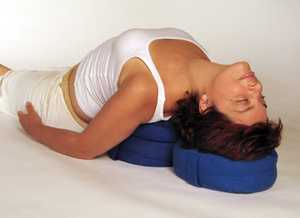 «The Supported Fish» — a Variation from Yin Yoga
«The Supported Fish» — a Variation from Yin Yoga
The Dissolution of the Position of Matsyasana
➳To release the position, breathe in and raise your head while you consciously look at your toes.
➳With the exhalation lower your upper body and head gently to the floor.
➳Free your arms and dwell in «Shavasana» as an intermediate relaxation.
➳Trace the effect of «Matsyasana». Emotional tensions can now be released more easily. A feeling of release is created. It is important to integrate these experiences into your own consciousness.
Tips for execution
➳When entering in the position, the buttocks tend to slide forward, so that the position of the hands to the buttocks is no longer the same as when lying down. But this should remain so, also in the position. When straightening up your upper body and head, make sure that you do not slide forward.
➳Once in the position, make sure that you work into the upper back. Shoulders away from your ears, pull your shoulder blades together. Always pay attention to your breathing. Visualize something beautiful or someone you love very much (guru, partner) in your heart and imagine that you want to carry them a little further into the sky.
➳Always pay attention to a deep and even breathing, the focus here is on the chest.
➳The legs keep a certain basic tension, but should not be pressed or tensed. As always: Relax all muscles that are not needed for an Asana (the holding of a position).
➳The concentration is energetically directed towards the spiritual heart center.
➳The coming out is as controlled as the going in. The body should lie symmetrically.
➳The general rule for «Matsyasana» in the Yoga-Vidya series is: Holding while ten breaths.
Supported Fish: Sometimes it is also useful to practice «Matsyasana» with cushions as an aid, so that no arm strength is needed. Thereby the arms can be laid to the side or even backwards. This passive variant is very pleasant and is often practiced in Yin-Yoga in this way. However, there the positions are taken for at least three minutes and not exceeded more than ten minutes.
Thoughts about Matsyasana
In «Matsyasana» we are not allowed to act, to hold anything, to carry anything. We hide the arms under the back, bring the hands far down, lean on the forearms and arch the chest very high up to the sky. The air can flow in freely, we tank up on oxygen, life energy, «Prana». We are completely filled with it in deep Yoga breathing. With increasing practice and the flexibility of the shoulder joints and the spine, we climb higher and higher, the vertex lies more and more easily on the floor.
In the beginning it might still be difficult, the chest doesn't really want to detach from the ground, the breath doesn't want to flow freely, we can't really let go yet. Even the arms can feel pressed, overstrained with the body weight, the hands are restricted, superfluous. It is too unusual to hardly use the extremities. Maybe we feel like an armless penguin that looks clumsy on land, although it glides elegantly through the water. Or like a seal, which uses its fins for support and pulls its heavy body behind it. But we are not passive in «Matsyasana» either. We can only achieve so much through deep breathing. By concentrating on what life is all about.
It does you good to put yourself back into the sea, the element water, where all life came from. Where we also spent the first months of our life, in the uterus filled with fruit water. Water has no bars, here you can feel the infinite blue expanse, the weightlessness. The fish swims freely, alone, but also in a shoal, a wonderful sight, when all the fish make a turn at the same time, without recognizable guidance, without lengthy communication, as if without delay a mass of individual beings becomes a single perfect organism, with one goal, one will, one body.
The Asana may perhaps convey this feeling to us, the wonderful feeling of security and joy to be carried by the water that is always around us and carries us. Surrounded by other like-minded people, with whom we sometimes feel more or less intensively connected, but with whom we also are always connected. Grateful that we are constantly supplied with energy through our breathing and are constant in exchange with our surroundings. In this way we feel an original joy and lust for life in the face of this great miracle of life.
Source: http://www.yoga-vidya.de/de/service/blog/asanas-der-yoga-vidya-grundreihe-matsyasana-der-fisch/
Matsyasana or Fish — Practical Instructions (excerpt beginner lesson)
Exercise Video, in which Sukadev instructs Matsyasana or Fish
The Yoga Exercise «Fish» or «Matsyasana» from a Yoga Lesson: Sukadev guides you to the exercise «Fish» or «Matsyasana» and shows you how to perform this exercise in an optimal and body-compatible way. This is an excerpt from the first course video of the 10-week beginner course http://mein.yoga-vidya.de/yoga-anfaengerkurs-video.
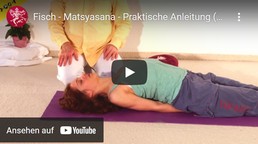
 |
 |
Counter-Position and Tracing
Then slowly lower your chest, put your hands under your head, lift your head gently and fold your hands behind your head. Now raise your head slightly and gently stretch your neck. If you like, you can also turn the head slightly to the left and right. Then bring the head back to the middle, lower the head and come into the «Back Relaxation Position».
The arms lie beside the body, the palms point upwards, the shoulders are away from the ears, the neck is long and the feet are about 50-70 cm apart. Alternatively you can leave the soles of your feet on the floor and bring your knees together. Breathe deeply in and out. Maybe you can now feel your heart in particular because the «Matsyasana», the «Fish», has especially activated your «Heart Chakra». Breathe in to your belly and send the energy from your belly via your heart to your throat as you exhale. Again and again as you breathe in via the heart to the belly and as you breathe out from the belly via the heart to the throat. Breathe in this way again and again deep with your belly. Through the Abdominal Breathing you keep the «Prana», the life energy, in motion and through the direction of consciousness you let the «Prana» flow to where your consciousness is going.
Swami Sivananda about Matsyasana — Variation
Since this Asana will help one to float easily on water with «Plavini Pranayama», it is called «Fish Position» or «Matsyasana».
Method
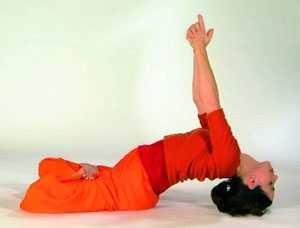 «Matsyasana» — with «Kali Mudra»
«Matsyasana» — with «Kali Mudra»
Spread out a cloth, sit in the «Padmasana» so that your right foot is above your left thigh and your left foot is above your right thigh. Then lie flat on your back. Relax your head on the crossed forearms. This is a variation.
Straighten and stretch your head backwards so that the vertex rests firmly on the floor on one side and only the ischial tuberosities are on the other side. In this way you make a bridge or a kind of arch that comes from the torso. Put your hands on your thighs or grab your toes with your hands. This will give your neck an intense stretch. This variation is more effective than the previous one. The benefit you can get from this version is a hundred times higher than the one from the version described before.
Obesity-prone people with thick calves who find it difficult to take «Padmasana» (foot lock) may simply remain in a normal sitting position and then practice the Asana. Practice «Padmasana» first. Hold it firmly, lightly and steadily. Then move into «Matsyasana». At the beginning hold this Asana for 10 seconds and then increase to 10 minutes.
To come out of the Asana, slowly free your head with the help of your hands and straighten you up. Then release the foot fastener.
You have to practice this Asana after «Sarvangasana». It will loosen the stiffness in the neck and relieve any cramping in the neck and throat area that may have arisen from holding «Sarvangasana» for a long time.
This will help you to get a natural massage by kneading the congested (tensed) areas of the neck and the shoulder area really gently. This will also allow you to get the most out of «Sarvangasana». The Asana complements «Sarvangasana». If the larynx or throat and windpipe are opened wide up and back in this way, it helps to breathe deeply. The tips of the lungs, which are located directly behind and above the collarbone (colloquially known as the neck bone), receive in this way adequate air and are supplied with sufficient fresh oxygen. The nerves concerning the neck and the upper dorsal nerves are supplied with a good amount of blood and stimulated in an appropriate way. The endocrine glands, namely the pituitary gland and the pineal gland, which are located in the brain, are thus stimulated and excited. These glands play an important role in the proper functioning of the various physiological systems of the body.
Benefit
«Matsyasana» is the destroyer of many diseases. The Asana removes constipation. It helps with the regulation of digestion. It is useful for asthma, tuberculosis, chronic bronchitis, etc., because of its deep breathing.
Sukadev about Matsyasana
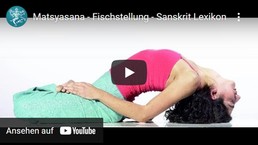
 |
 |
Sukadev about eating fish and to the 5 «N»
5 «N» — No fish, no meat, no drugs, no alcohol, no tobacco::
Video lecture by and with Sukadev about the 5 «N» — the recommendation for a spiritual aspirant of the Yoga-Vidya Tradition.
«5 N» — what does that mean?
➳no fish
➳no meat
➳no alcohol
➳no drugs
➳no tobacco
Why does Sukadev put so much emphasis on those 5 «N»? Sukadev is talking here about health, psychological and subtle reasons. But the most important are the ethical reasons. Why one should abstain from meat, fish, alcohol, drugs and tobacco for ethical reasons, Sukadev talks about in this lecture video. This lecture is part of the series of lectures on Vicharana, the conscious spiritual aspiration. The series of lectures on the Vicharana is part of the series of lectures on the «Spiritual Path». And this in turn is part of the series of lectures on «Yoga-Vidya Schooling – The Holistic Yoga Path».
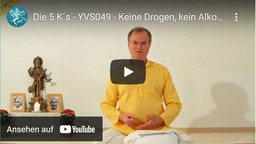
 |
 |
This is also the forty-ninth lecture in the series «Yoga Vidya Schooling». For further information, please see the keywords spirituality and bhumika.
Videos of the performance of Matsyasana
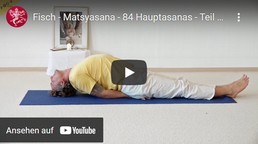
 |
 |
Matsyasana for Advanced
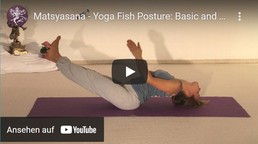
Videos about Lotus Fish and Supported Fish
The Lotus Fish, simple variation of an advanced exercise
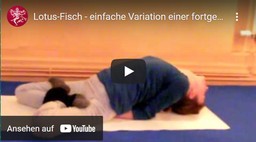
 |
 |
Supported Lotus Fish
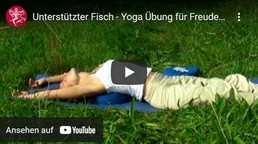
 |
 |
Assistance for Matsyasana
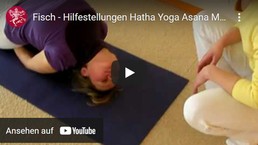
 |
 |
